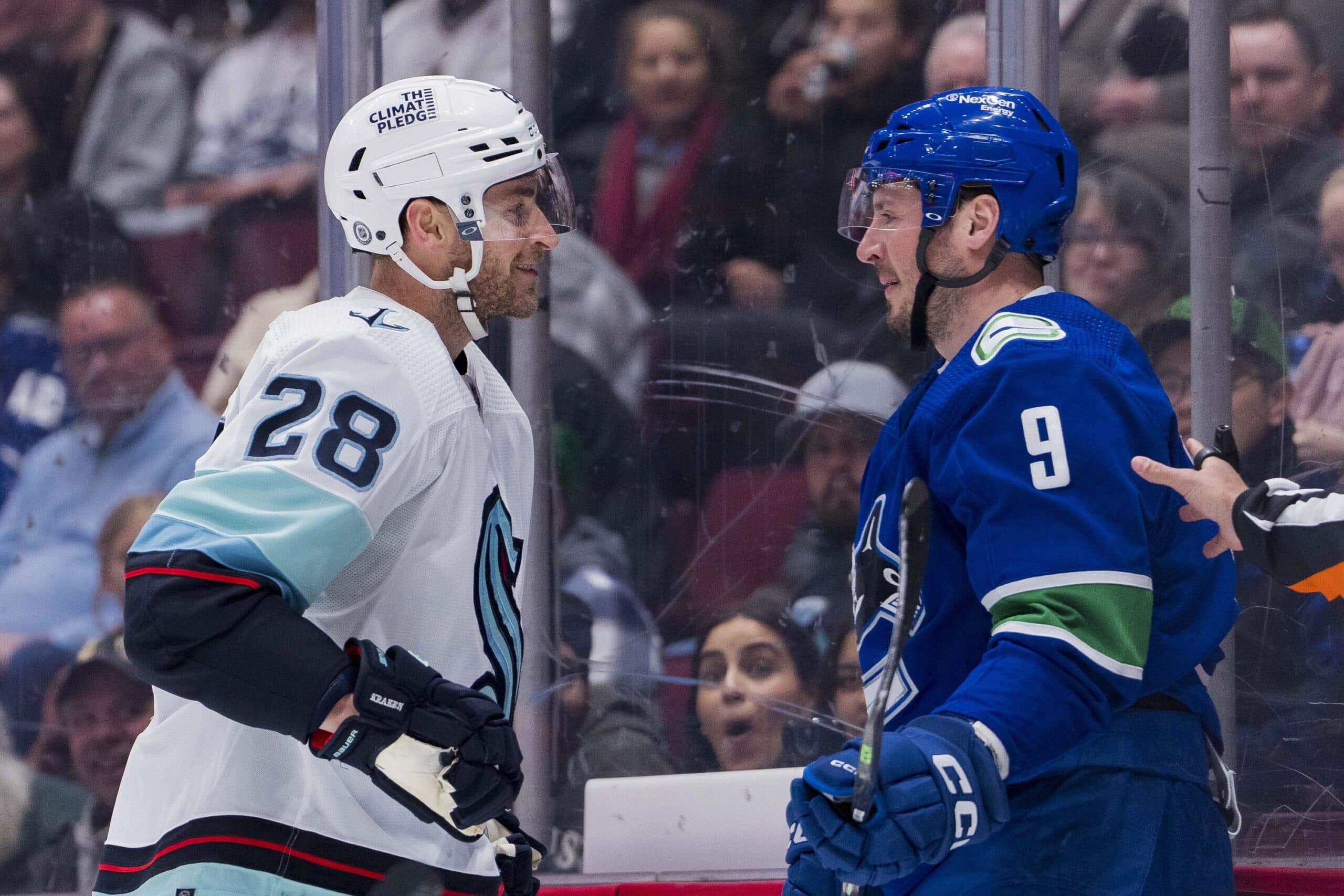The Seattle Kraken are in the second round of the Stanley Cup Playoffs, and it’s given Canucks fans something to mull over: to root or not root for the team just across the border? Regardless of where fans fall in this debate, the bigger question remains, how does a Kraken team with less talent than the Canucks make the playoffs? The answer is contributions.
If it wasn’t apparent in the Kraken lineup this regular season, it’s unmistakable now. The Kraken excel at scoring in bunches and are doing so with an entire army of players. As impressive as their leading scorer Jared McCann has been all season long, the Kraken have been just fine without his presence in the lineup for the last six games.
But if the same would happen to Elias Pettersson, the Canucks would be a noticeably different team. Unlike the Kraken, the Canucks’ success weighs almost entirely on the backs of five players: Pettersson, J.T. Miller, Quinn Hughes, Andrei Kuzmenko, and Brock Boeser. While each NHL team is constructed with their core in mind, a team’s big guns can’t do it all in an ultra-competitive league. In the Canucks’ case, if each of these players, or at least a few of them, aren’t at the top of their game, the team doesn’t have a fighting chance to win. And with Boeser’s reduced productivity, the Canucks become even more reliant on their top line.
However, the Canucks have more than enough talent to challenge for a playoff run. Although the bubble format allowed more teams to play in the postseason, the Canucks outlasted and took out the defending Stanley Cup Champions, and brought their series against Vegas to a deciding game seven with far less firepower then. Now, for the first time in 13 years, the Canucks have a 100-point player on the team. Only 10 other players in the NHL accomplished what Pettersson did this season. The Kraken didn’t have a single player surpass 70 points, and four Canucks players did.
Canucks players don’t have a shortage of talent; the Canucks don’t have enough secondary scoring.
Kraken players might not have more than 70 points, but they have a neater point spread. The Kraken’s largest deferential among players is 12 points, and that separates the team’s worst defenceman from a forward who played less than 15 games all season. Outside of the Canucks’ top four scorers, the next-best player, Boeser, has 19 fewer points. The Kraken compensate for less individually skilled players with a balanced lineup, promoting the motto “more scorers, more ways to win,” instead of requiring their top players to log more ice time. McCann logged an average of 4:13 seconds less than Pettersson, but still had one more goal on the season.
Pettersson didn’t record a single point in just three of the Canucks’ 38 wins. In the 35 wins Pettersson was able to get on the board, he recorded 69 points: a 68% share of his point total for the season. When Pettersson recorded at least one point, the Canucks were 35–25. When Pettersson failed to record at least one point, the Canucks were 3–17. The Canucks managed to score one goal in both of the games Pettersson didn’t play this season. On both goals, Hughes was the one to pick up a point, stepping up during the loss of the team’s leading scorer.
While the Kraken’s and Canucks’ top five players were virtually averaging the same percentage for shots-on-goal, not a lot of other Canucks players besides the top five were scoring goals. The Canucks may have had more players reach the 30-goal mark, but the Kraken had five 20-goal scorers in comparison to the Canucks’ zero. The Canucks’ top five goal scorers were the team’s assist leaders, whereas two of the Kraken’s top five assist leaders varied from their goal scorers.
The Canucks’ lack of spread-out scoring isn’t just a problem among forwards, it’s impacting defencemen as well. The Canucks’ 22 goals scored by defencemen were the fewest in the NHL. The next closest team was the Toronto Maple Leafs, who scored 27 goals. On the other hand, the Kraken were the seventh-best in the league with 44 goals scored by defencemen: double the amount the Canucks had.
While not all of the Canucks’ tribulations can be placed on their lack of depth scoring, the team wasted a 100-point player’s season by having no playoffs to show for it. These types of seasons haven’t come easy for Canucks players. Aside from Pettersson, only six players have recorded a 100-point season for the Canucks, two of those seasons coming from Pavel Bure. Considering how skill-heavy the Canucks’ top six forwards are in comparison to their bottom six, the team either needs to see an improvement from their bottom half, shell out more money to acquire bottom six players known to produce, or transition high-scoring AHL players into this position, with the risk of them not becoming accustomed to playing in the NHL fast enough. These decisions need to be made sooner rather than later as Pettersson is on the cusp of entering what will very likely be the prime of his career, and 20-point seasons can’t and won’t be enough for the team’s bottom six.


